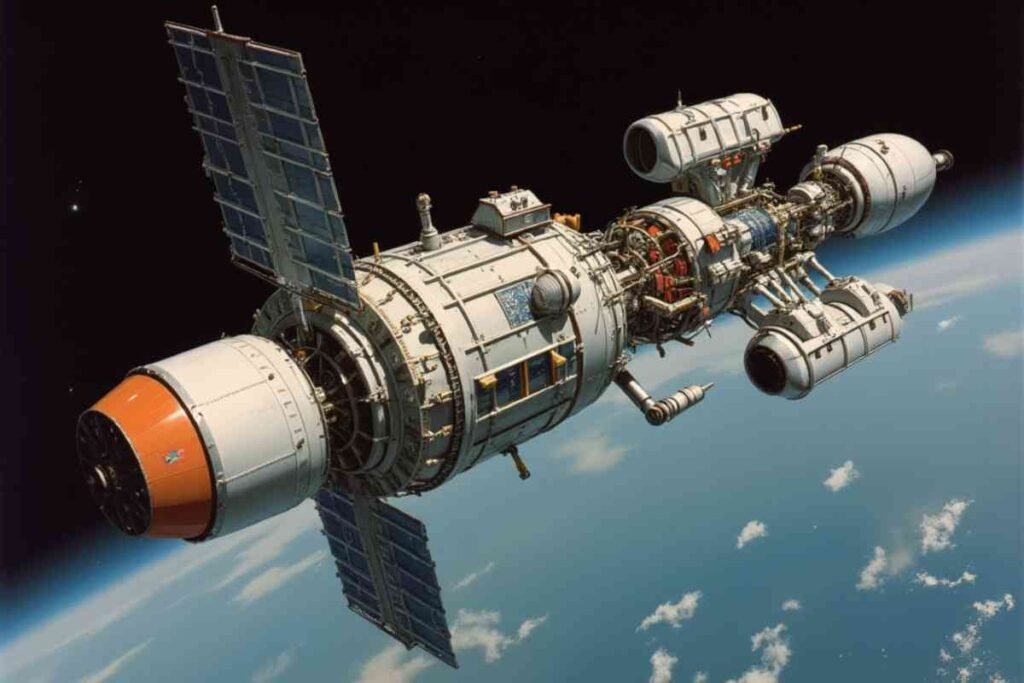Arabella and anita were two small spiders sent by NASA to Skylab for a space experiment.They showed how webs could be built even in the weightless environment of space.
This experiment gave scientists a new way to understand life beyond Earth.Their webs proved that even tiny creatures can adapt in surprising ways.
Arabella and Anita became famous as the first spiders in space history.Their story still attracts readers who love science and space adventures.
The Background of Skylab and Space Biology

Skylab was America’s first space station launched in 1973 designed to study how humans and other living things adapt to space.
It provided astronauts with a laboratory in orbit where they could conduct medical biological and scientific experiments.One of its major goals was to understand the effects of weightlessness on the human body and living organisms.
These experiments in space biology laid the foundation for modern space research and future missions beyond Earth.
NASA’s Skylab Program
Before Arabella and Anita ever entered the picture NASA launched Skylab the first United States space station in May 1973.
Skylab’s purpose was to serve as a laboratory in orbit where astronauts could conduct long duration missions and test how microgravity affected both equipment and living organisms.
The station provided an unprecedented opportunity for scientific experiments ranging from solar physics to biology.
The Role of Biology in Space
Space exploration has always been about more than rockets and satellites. Understanding how life responds to microgravity is essential if humans are to live and work beyond Earth.
Microgravity biology became an important field of study with experiments involving plants fish insects and other organisms. The spider web experiment was one of the most imaginative of these projects.
How the Spider Experiment Was Chosen?
The experiment with Arabella and Anita was not initially conceived by NASA scientists but by Judith Miles a 17 year old high school student from Massachusetts.
In 1972 she proposed the idea as part of a NASA program encouraging students to contribute research ideas for Skylab missions.
NASA embraced the proposal because spider web formation offered a direct way to study the effects of microgravity on coordination and nervous system activity.
The Journey of Arabella and Anita to Space
Arabella and Anita’s journey to space became a remarkable scientific experiment showing how spiders adapt to zero gravity.
Their mission aboard Skylab inspired curiosity worldwide proving that even tiny creatures can contribute to space exploration.
Selection of the Spiders
Arabella and Anita were both cross spiders also known as European garden spiders. They were chosen for their web building abilities which could be clearly observed and documented in the controlled environment of Skylab.
Two spiders were included to provide redundancy in case one did not survive or failed to adapt to space conditions.
Launch on Skylab 3
On July 28 1973 Arabella and Anita were sent into orbit aboard Skylab 3 the second crewed mission to the space station.
The astronauts on this mission were Alan Bean Jack Lousma and Owen Garriott. Along with many other experiments they were tasked with observing the spiders and recording their behavior in microgravity.
Initial Observations
When Arabella was first introduced into her experimental container she struggled to adapt. The first webs she spun were rudimentary and lacked the symmetry of Earth made webs.
However as the days passed Arabella learned to compensate for the lack of gravity and produced more complete and structured webs. Anita was later introduced mid mission and she too began building webs after initial difficulties.
The Web Experiment in Microgravity
The Web Experiment in Microgravity was designed to study how spiders spin webs in space without the pull of gravity.
This unique experiment helped scientists understand behavior changes in microgravity and inspired future space biology research.
Web Building Challenges
Spiders on Earth rely on gravity to position themselves and determine the thickness and strength of their silk. Without gravity Arabella and Anita initially appeared disoriented.
Their first attempts were uneven but remarkably they quickly adapted showing just how flexible life can be in alien conditions.
The Results of the Experiment
By the second day Arabella was spinning webs that were almost as structured as those built on Earth. Anita also succeeded and together they proved that spiders could adjust their instincts in space.
Interestingly the silk they produced was finer than usual a detail that intrigued researchers studying the neurological and physiological aspects of web construction.
Broader Scientific Implications
The web experiment was about more than just arachnids. NASA explained that the structure of a spider’s web reflects the condition of its central nervous system.
By studying Arabella and Anita’s ability to spin webs in space scientists gained clues about how the human nervous system might also adapt in microgravity. This was critical for long term space missions and the possibility of human colonization of other planets.
The Lives and Legacy of Arabella and Anita
The Lives and Legacy of Arabella and Anita explore the remarkable journeys of two inspiring figures who left a lasting mark in their fields. Their stories highlight dedication creativity and the impact they made on generations to come.
The Tragic End
Despite their success in adapting both Arabella and Anita died during the Skylab 3 mission most likely from dehydration. Their deaths were unfortunate, but their contribution to science was already secured.
Arabella’s body was returned to Earth and later displayed at the Smithsonian’s National Air and Space Museum. Anita was also preserved and eventually made available for public display.
The Educational Impact
Arabella and Anita became famous not only for their scientific significance but also for their role in inspiring young people. The fact that a high school student’s idea was accepted and implemented by NASA demonstrated the value of creativity and youth participation in science.
This story has been retold in classrooms for decades encouraging students to think boldly about science and exploration.
Scientific Lessons from the Skylab Spiders
The Skylab spider experiment taught scientists how zero gravity affects spider web building revealing changes in structure and patterns.
These insights help researchers understand how animals adapt in space offering valuable lessons for future long term space missions.
Insights into Microgravity Biology
Arabella and Anita’s experiment showed that adaptation is possible even in the absence of gravity. For scientists this was an important lesson in microgravity biology.
If spiders could reorient their instincts and spin effective webs in space it suggested that humans might also adapt their motor functions to new conditions.
Nervous System Adaptation
The experiment highlighted how the central nervous system responds to environmental change. Since web construction is tied to sensory input and motor coordination studying the Skylab spiders provided indirect evidence about how other organisms including humans might cope with the challenges of space life.
Applications for Human Spaceflight
Understanding nervous system adaptation has direct implications for astronauts. Arabella and Anita’s success suggested that with time and training astronauts could learn to perform complex tasks in microgravity.
This lesson continues to inform astronaut preparation for missions to the International Space Station and beyond.
Arabella and Anita in Popular Culture

Arabella and Anita have become iconic figures in popular culture inspiring films books and art that celebrate their unique personalities. Their stories and adventures continue to captivate audiences making them enduring symbols of creativity and charm.
Public Fascination
When news of the Skylab spiders spread people were fascinated. Newspapers and television reported on their progress and the story reached households worldwide. Arabella and Anita became unlikely celebrities symbols of science’s creativity and curiosity.
Symbolism of the Spiders
The spiders represented resilience adaptability and the spirit of exploration. Their story was not only about space biology but also about human ambition and the drive to discover. Even today Arabella and Anita are remembered as part of space history’s most unusual experiments.
Continuing Relevance of the Skylab Spiders
The Skylab spiders continue to be significant in space research showing how microgravity affects living organisms.Their experiments provide valuable insights for modern biology and space exploration attracting ongoing scientific interest.
Ongoing Educational Inspiration
Teachers and scientists continue to reference the Arabella and Anita experiment to show students the possibilities of contributing to space research. The experiment stands as proof that innovative ideas, no matter where they come from, can change the direction of science.
Both the Skylab spider experiment and crossdressing stories explore unique journeys of adaptation self expression and courage highlighting how individuals whether humans or animals navigate unfamiliar environments and inspire learning creativity and acceptance.
Conclusion
Arabella and Anita’s journey to space showed that even the smallest creatures can achieve extraordinary feats in challenging environments. Their ability to spin webs in microgravity revealed remarkable adaptability and provided crucial insights into nervous system function.
This experiment not only advanced our understanding of microgravity biology but also highlighted the importance of creativity and youth involvement in science.
Though their lives in space were brief their legacy continues to inspire generations reminding us that curiosity innovation and determination can push the boundaries of exploration and discovery.
FAQs
What were Arabella and Anita famous for?
Arabella and Anita were the first spiders sent to space aboard Skylab. They became famous for spinning webs in microgravity, showing that even small creatures can adapt to space conditions.
Why did NASA choose spiders for the Skylab experiment?
Spiders were chosen because their web-building skills offered a clear way to study behavior in zero gravity. Observing them helped scientists understand nervous system adaptation in microgravity.
Who proposed the spider experiment for Skylab?
The idea was proposed by Judith Miles, a 17-year-old high school student. NASA accepted her concept, demonstrating the value of youth contributions to scientific research.
How did Arabella and Anita adapt to microgravity?
Initially, the spiders struggled to build structured webs, but they quickly adjusted. Over time, their webs became organized, showing remarkable adaptability to weightless conditions.
What did scientists learn from the spider web experiment?
The experiment revealed that animals can adapt motor coordination and instincts in microgravity. It offered insights into how humans might perform complex tasks in space.
What happened to Arabella and Anita after the experiment?
Both spiders died during the Skylab mission, likely due to dehydration. Arabella’s remains were displayed at the Smithsonian, and Anita’s were preserved for public education.
How did Arabella and Anita inspire education?
Their story showed students that creativity and bold ideas could lead to real scientific contributions. The experiment continues to inspire young people in classrooms worldwide.
Why is the Skylab spider experiment still relevant today?
It provides ongoing insights into microgravity biology and nervous system adaptation. The findings continue to influence space research and astronaut training for long-term missions.